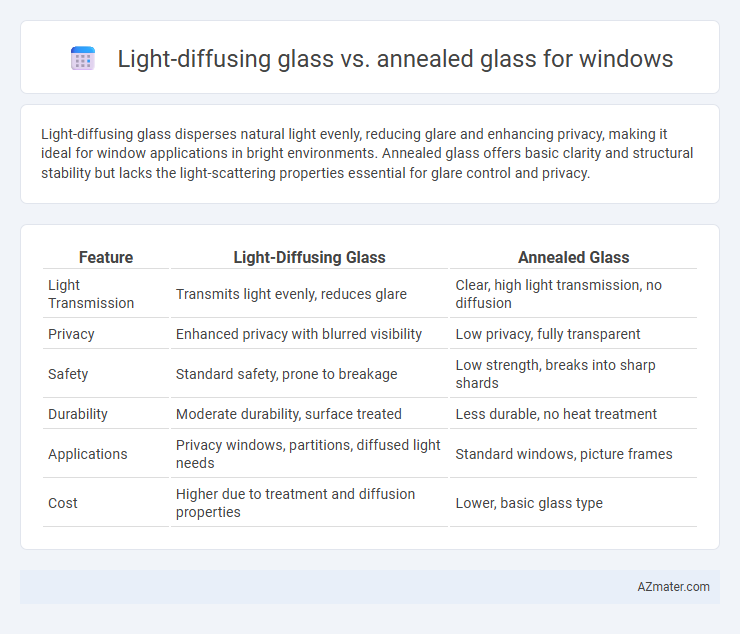Light-diffusing glass disperses natural light evenly, reducing glare and enhancing privacy, making it ideal for window applications in bright environments. Annealed glass offers basic clarity and structural stability but lacks the light-scattering properties essential for glare control and privacy.
Table of Comparison
| Feature | Light-Diffusing Glass | Annealed Glass |
|---|---|---|
| Light Transmission | Transmits light evenly, reduces glare | Clear, high light transmission, no diffusion |
| Privacy | Enhanced privacy with blurred visibility | Low privacy, fully transparent |
| Safety | Standard safety, prone to breakage | Low strength, breaks into sharp shards |
| Durability | Moderate durability, surface treated | Less durable, no heat treatment |
| Applications | Privacy windows, partitions, diffused light needs | Standard windows, picture frames |
| Cost | Higher due to treatment and diffusion properties | Lower, basic glass type |
Introduction to Light-Diffusing Glass and Annealed Glass
Light-diffusing glass incorporates microscopic textures or coatings that scatter incoming light, reducing glare and enhancing privacy while maintaining brightness, making it ideal for contemporary window designs requiring soft, even illumination. Annealed glass, also known as standard float glass, undergoes a slow cooling process to relieve internal stresses, offering clarity and cost-effectiveness but lacking the light-scattering properties and increased strength of tempered variants. Choosing between light-diffusing and annealed glass depends on balancing aesthetic preferences, privacy needs, and performance requirements in architectural applications.
Composition and Manufacturing Processes
Light-diffusing glass incorporates additives such as ceramic frits or etched patterns during manufacturing, creating microscopic structures that scatter light and reduce glare. Annealed glass is produced by gradually cooling molten glass in a controlled environment to relieve internal stresses without altering its transparent, smooth surface. The key difference lies in light-diffusing glass's modified surface or embedded materials for diffusion, whereas annealed glass emphasizes stress relief and maintains optical clarity through its uniform cooling process.
Optical Properties and Light Transmission
Light-diffusing glass scatters incoming light to reduce glare and soften illumination, offering diffuse transmission that enhances privacy while maintaining brightness. Annealed glass, being standard float glass, allows high levels of direct light transmission with minimal distortion but provides no diffusion or privacy features. Optical clarity in annealed glass is superior for unobstructed views, whereas light-diffusing glass excels in managing light quality and reducing harsh shadows.
Energy Efficiency and Thermal Performance
Light-diffusing glass enhances energy efficiency by scattering natural light evenly, reducing the need for artificial lighting and lowering electricity consumption. Annealed glass, while affordable and easy to produce, lacks advanced thermal performance and often requires pairing with additional coatings or laminated layers to improve insulation. Choosing light-diffusing glass optimizes thermal regulation by minimizing heat transfer, contributing to reduced heating and cooling costs throughout the year.
Privacy and Glare Control Features
Light-diffusing glass enhances privacy by scattering incoming light, preventing clear visibility while maintaining natural illumination, making it ideal for spaces requiring discreet lighting. Annealed glass offers minimal privacy as it is clear and transparent but can be combined with films or shades for glare control. In terms of glare reduction, light-diffusing glass naturally softens harsh sunlight, reducing eye strain, whereas annealed glass requires additional treatments like tinting or coatings to manage glare effectively.
Strength and Safety Considerations
Light-diffusing glass enhances privacy by scattering light while maintaining visibility but typically has reduced impact strength compared to annealed glass, making it less resistant to breakage. Annealed glass, the standard untreated glass, offers basic safety and strength but shatters into large, sharp shards upon impact, posing higher injury risks. For enhanced safety, annealed glass is often combined with laminates or tempering processes, whereas light-diffusing glass requires careful layering to balance light transmission with structural integrity.
Design Versatility and Aesthetic Appeal
Light-diffusing glass enhances design versatility by scattering natural light, creating softly illuminated spaces while maintaining privacy, making it ideal for modern and artistic window applications. Annealed glass offers a sleek, clear aesthetic that maximizes transparency and sharpness, providing a classic look suitable for minimalist or traditional designs. The choice between the two depends on the desired balance between aesthetic appeal and functional diffusion of light in architectural projects.
Application Scenarios in Modern Architecture
Light-diffusing glass enhances privacy and natural lighting in residential and commercial buildings by evenly scattering sunlight, making it ideal for office partitions, bathroom windows, and facades requiring glare reduction. Annealed glass, known for its clarity and strength in standard applications, suits large window panes and storefronts where optical transparency and cost-effectiveness are priorities. Modern architecture leverages light-diffusing glass in innovative designs emphasizing visual comfort and energy efficiency, while annealed glass supports structural elements needing straightforward fabrication and installation.
Maintenance and Long-Term Durability
Light-diffusing glass requires minimal maintenance due to its ability to mask fingerprints and smudges, reducing the need for frequent cleaning compared to annealed glass. Annealed glass, while durable, is more prone to surface scratches and blemishes, necessitating regular upkeep to maintain clarity. Long-term durability favors light-diffusing glass as its specialized coating enhances resistance to environmental wear and discoloration, extending its lifespan in window applications.
Cost Comparison and Value for Window Installations
Light-diffusing glass typically costs 20-30% more than standard annealed glass due to its advanced surface treatments that scatter light evenly, enhancing privacy and reducing glare. While annealed glass is cost-effective for basic window installations with minimal light control, light-diffusing glass adds value by improving natural lighting quality and energy efficiency, potentially lowering long-term utility expenses. Choosing light-diffusing glass balances higher upfront investment with enhanced aesthetic and functional benefits, making it a preferred option for premium residential and commercial windows.

Infographic: Light-diffusing glass vs Annealed glass for Window
 azmater.com
azmater.com